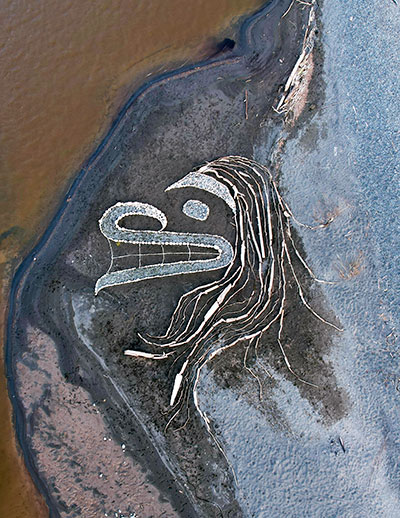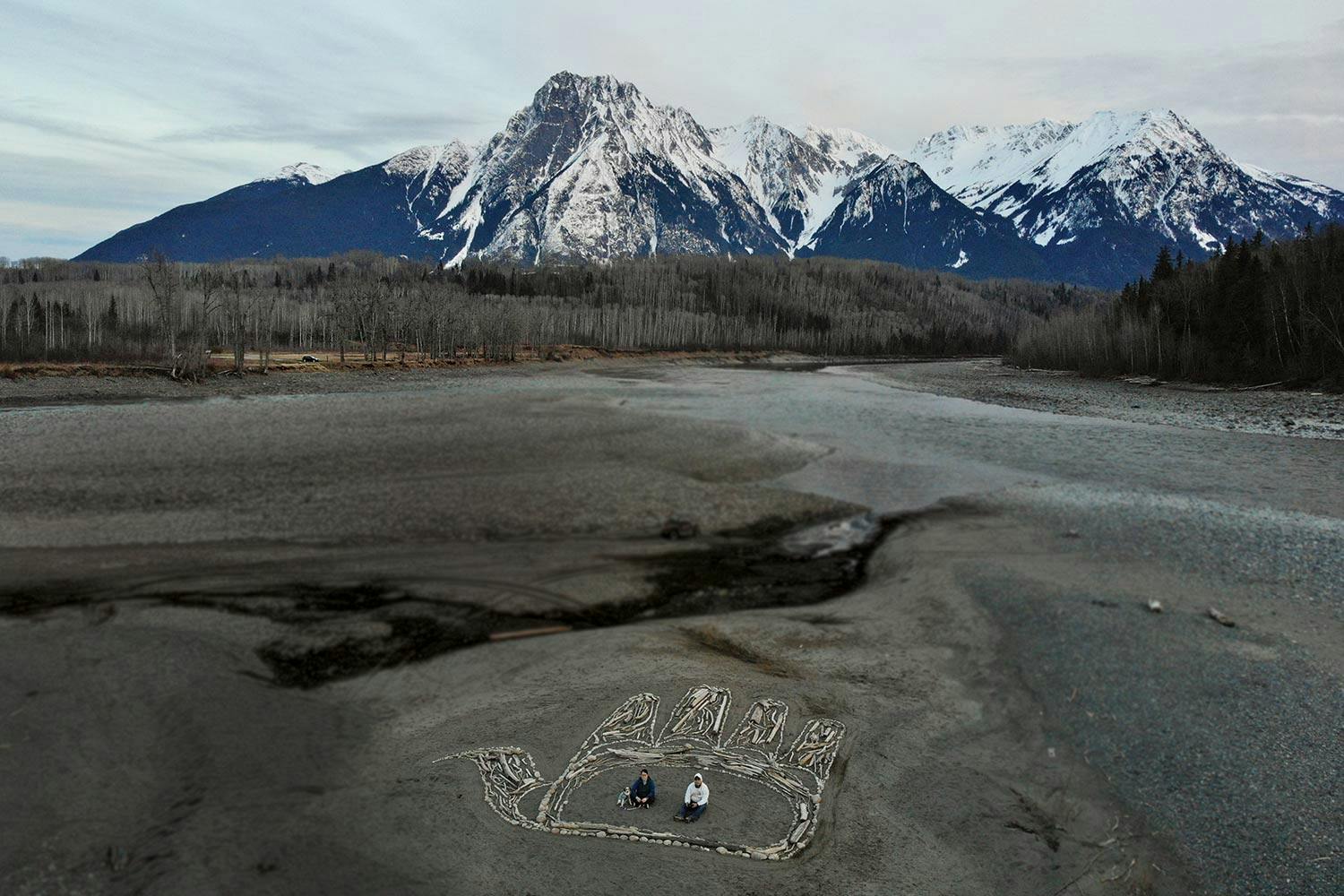Making Art from Nature
These Gitxsan siblings create impermanent artworks from objects they find along the Skeena River.
Michelle and Alex Stoney sit in the centre of one of their formline artworks.
Driving along Highway 16 up from the BC coast, you’ll wind along a wide river through the curved, misty peaks of slow mountains densely populated by cedar, spruce, fir, hemlock, and alder. This river, the Skeena, has tides up until about Terrace, from where it begins to lose its memory of the ocean. During the spring ooligan-fishing season, families park on the sandbars to fish while seagulls, eagles, and ravens swarm waiting for their fill.
The Skeena guides salmon into other rivers, including that of my own nation, the Babine River. However, before you reach the northern part of the river to follow that branch, you’ll arrive where the Skeena meets the Bulkley, at the home of two Gitxsan artists and siblings, Alex and Michelle Stoney.
“I don’t know if all young kids think this way, but I kind of took where I lived for granted, and always said to myself I was going to move away, can’t wait to get out of Hazelton,” Michelle muses. “But after living down south and going to school in Vancouver, and travelling a lot of the world, I realized how special we have it here.”
It is difficult to describe the depth of our relationship as Indigenous people to the water and salmon fed by this watershed. But I, like Michelle, also find my appreciation of our home communities has evolved over time. A few years ago, while I travelled in the southern part of Sápmi — the traditional homelands of the Saami people in northern Europe — I was reminded heart-wrenchingly of home. When I began to see the fish farms dotting the fjords, I was overcome with a choking grief, imagining what could become of our waters. For many families, our reliance on the salmon run is, without exaggeration, life or death: If the salmon stop returning, it would mark the death of one of our deepest and longest-standing relationships.
I took where I lived for granted, and always said I was going to move away. But after travelling a lot of the world, I realized how special we have it here.
But this relationship isn’t over, and with artists like the Stoneys, its importance often becomes centred in their artwork. That art can be found along the banks of the Skeena and Bulkley: large-scale works composed of long, slender pieces of driftwood and stones carefully selected for their colour and how they contrast against the sand.
These pieces, designed by Michelle, are contemporary takes on traditional Gitxsan formline art. Formline is a style that varies between Indigenous nations along the Pacific coast and its waterways, most quickly recognized for its use of ovoid shapes with connective “s” and “u” shapes. It’s used to create portraits and animal forms, and can be applied across many mediums, including paintings, carvings, and tattoos.

Rather than permanently alter the landscape, the Stoneys’ art is meant to fade back into its environment.
Formline work from this region tends to be marked by bold shapes, with thick swathes of solid colour. In the work of the Stoney siblings, with these natural materials gathered from the shores of the rivers, they’re muted. Each piece has a precise spareness. Rather than giving a diminishing appearance, however, they look lively, as though they’ve been washed in by the water for a brief appearance.
The land art that is taught within art history is largely from the 1960s and ’70s. Robert Smithson’s Spiral Jetty (1970) comes to mind first: a massive man-made berm curling into Utah’s Great Salt Lake. Or Michael Heizer’s Double Negative (1969), two enormous trenches cut into the Moapa Valley near Overton, NV. Though the movement is characterized by largely white, male creators, I would be remiss to not mention Nancy Holt’s Sun Tunnels (1973–76), a work that placed concrete tunnels large enough to walk through in the Great Basin Desert outside the ghost town of Lucin, UT.
What marks that movement is that its works often leave an impression or monolith on the earth. The land is a medium or backdrop, and less of a relational exchange between land and human entities. The works are intended to stay, until the people who made them decide to have them removed.
I imagine walking along the river and seeing the form of a hand with a palm so large that two people can comfortably lay in it, as demonstrated by Alex’s drone photographs of the work. What marks this as separate from the land art of the 70s is the modesty of the engagement despite its scale. Both say that initially they’d done the work for themselves, and Michelle adds wryly that she was “being selfish — I just wanted to see how it would look.” How it looks is warm, inviting, and joyful — and like it’s about to be lovingly subsumed back into the middle place of water and land.
The work caught on though. Soon it appeared in Facebook feeds, with community members delighted and asking who was responsible. It’s a small community; there couldn’t possibly be a way to stay anonymous. As new iterations came, the artists encouraged the community to add their own embellishments. People are usually shy about the invitation, however.
I ask them about the impermanence, if it feels like a natural part of the work. They both say yes, with the caveat that Alex’s photographs preserve them, and say that as the work became more known they started getting questions about if they could make it a permanent public work. They’ve thus far declined, because, as Alex says, “what’s important to us is we didn’t want to harm—we’re making art from nature and it’s going back into nature.”
How it looks is warm, inviting, and joyful—like it’s about to be lovingly subsumed back into the water and land.
For this reason, they were approached by a friend, Leah Pipe, a non-Indigenous artist in the area. Pipe asked if they would like to create a community-engaged work on behalf of the Skeena Watershed Conservation Coalition (SWCC) to raise awareness of the dangerously low salmon runs that have been plaguing the region for the past dozen years.
Michelle and Alex tell me about growing up smoking fish in the traditional way. “We were working all summer growing up, and now we only work a couple weeks,” Michelle tells me. This strikes close to home. Several years ago, my nation decided to take no fish from this same watershed due to low counts. “A bad year” can’t explain what’s happening to the salmon anymore, and the word “catastrophic” has begun to loom larger each year.
They accepted the invitation from SWCC and with the help of volunteers, created a more than 4o-metre salmon on the riverbanks. A befitting, communal work to reflect the increasing enormity of the issue.
To describe these works as an act of decolonizing suggests that Michelle and Alex have been inspired by and are working back from the land art movement of the 1970s. But in my mind they’re more connected to a different tradition. I think instead of Rebecca Belmore’s sound installations Ayum-ee-aawach Oomama-mowan: Speaking to Their Mother (1991, 1992, 1996) and Wave Sound (2017).
In each work, Belmore places large sculptural horns on the land. The sculpture from Speaking amplifies the voices of participants, and Wave Sound coalesces the natural sounds of the land to be reverberated back for listening. These contemporary Indigenous works invite audiences, especially Indigenous ones, to engage in instinctive, frank conversation with the land we’re on — to recognize the land as in dialogue with human life, rather than as a static entity without agency, to be extracted from.
Similarly, Michelle and Alex Stoney encourage participation by extending an invitation to draw materials from your surroundings to collaborate with the banks of the river. Beyond spoken language, the time spent with their works — and potentially with your own welcome embellishments — places you between land and water to listen to the shape of the land, to consider who else, human and non-human, is in the conversation.
Print Issue: Fall/Winter 2021
Print Title: Spoken on the Shores
